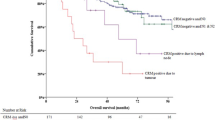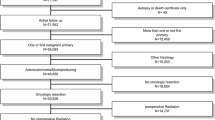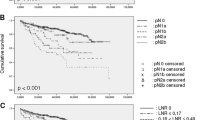Abstract
Background
Patients with rectal cancer are treated in multimodal concepts on the basis of their tumor stage. In the context of local excision, it is of major importance to assess the risk of lymph node metastases in patients with T1 or T2 tumors. To identify patients with an increased risk of lymph node metastases, the influence of the location of the tumor within the rectum (anterior, posterior, lateral) and of other variables on lymph node status was investigated.
Methods
All consecutive patients undergoing low anterior resection or abdominoperineal resection for primary rectal cancer between October 2001 and September 2003 were included. A multivariate analysis was performed focussing on tumor location and other variables as potential predictive factors for lymph node metastases.
Results
Of 148 included patients, 135 (91%) had an anterior and 13 (9%) an abdominoperineal resection. All patients routinely underwent total mesorectal excision. A statistically significant correlation with positive lymph node status was found for patients with lymphatic invasion (P < .0001), higher T stage (P < .0001), presence of distant metastases (M1) (P = .0003), and circular growth of the tumor (P = .003), but not for tumor location. Multivariate analysis confirmed that patients without lymphatic invasion (odds ratio, .1; 95% confidence interval, .02–.48; P = .006) and with a low T stage (odds ratio, .07; 95% confidence interval, .002–.9; P = .004) have a significantly lower risk for positive lymph nodes.
Conclusions
Location of rectal cancer (anterior, posterior, lateral) is not a good predictor for lymph node metastases.

Similar content being viewed by others
References
Heald RJ, Husband EM, Ryall RD. The mesorectum in rectal cancer surgery—the clue to pelvic recurrence? Br J Surg 1982; 69:613–6
Heald RJ, Ryall RD. Recurrence and survival after total mesorectal excision for rectal cancer. Lancet 1986; 1(8496):1479–82
Hermanek P, Wiebelt H, Staimmer D, Riedl S. Prognostic factors of rectum carcinoma—experience of the German Multicentre Study SGCRC. German Study Group Colo-Rectal Carcinoma. Tumori 1995; 81(3 Suppl):60–4
Preoperative short-term radiation therapy in operable rectal carcinoma. A prospective randomized trial. Stockholm Rectal Cancer Study Group. Cancer 1990; 66:49–55
Kapiteijn E, Marijnen CA, Nagtegaal ID, et al. Preoperative radiotherapy combined with total mesorectal excision for resectable rectal cancer. N Engl J Med 2001; 345:638–46
Sauer R, Becker H, Hohenberger W, et al. Preoperative versus postoperative chemoradiotherapy for rectal cancer. N Engl J Med 2004; 351:1731–40
Glimelius B, Gronberg H, Jarhult J, Wallgren A, Cavallin-Stahl E. A systematic overview of radiation therapy effects in rectal cancer. Acta Oncol 2003; 42:476–92
Chan AK, Wong A, Jenken D, Heine J, Buie D, Johnson D. Posttreatment TNM staging is a prognostic indicator of survival and recurrence in tethered or fixed rectal carcinoma after preoperative chemotherapy and radiotherapy. Int J Radiat Oncol Biol Phys 2005; 61:665–77
Chan CL, Bokey EL, Chapuis PH, Renwick AA, Dent OF. Local recurrence after curative resection for rectal cancer is associated with anterior position of the tumour. Br J Surg 2006; 93:105–12
Frykholm GJ, Pahlman L, Glimelius B. Combined chemo- and radiotherapy vs radiotherapy alone in the treatment of primary, nonresectable adenocarcinoma of the rectum. Int J Radiat Oncol Biol Phys 2001; 50:427–34
Brown G, Kirkham A, Williams GT, et al. High-resolution MRI of the anatomy important in total mesorectal excision of the rectum. AJR Am J Roentgenol 2004; 182:431–9
Kwok H, Bissett IP, Hill GL. Preoperative staging of rectal cancer. Int J Colorectal Dis 2000; 15:9–20
Lee SH, Hernandez de AE, Finne CO, Madoff RD, Garcia-Aguilar J. The effect of circumferential tumor location in clinical outcomes of rectal cancer patients treated with total mesorectal excision. Dis Colon Rectum 2005; 48:2249–57
Emslie J, Beart R, Mohiuddin M, Marks G. Use of rectal cancer position as a prognostic indicator. Am Surg 1998; 64:958–61
Topor B, Acland R, Kolodko V, Galandiuk S. Mesorectal lymph nodes: their location and distribution within the mesorectum. Dis Colon Rectum 2003; 46:779–85
Syk E, Torkzad MR, Blomqvist L, Ljungqvist O, Glimelius B. Radiological findings do not support lateral residual tumour as a major cause of local recurrence of rectal cancer. Br J Surg 2006; 93:113–9
Bleday R, Breen E, Jessup JM, Burgess A, Sentovich SM, Steele G Jr. Prospective evaluation of local excision for small rectal cancers. Dis Colon Rectum 1997; 40:388–92
Blumberg D, Paty PB, Picon AI, et al. Stage I rectal cancer: identification of high-risk patients. J Am Coll Surg 1998; 186:574–9
Brodsky JT, Richard GK, Cohen AM, Minsky BD. Variables correlated with the risk of lymph node metastasis in early rectal cancer. Cancer 1992; 69:322–6
Cooper HS, Deppisch LM, Gourley WK, et al. Endoscopically removed malignant colorectal polyps: clinicopathologic correlations. Gastroenterology 1995; 108:1657–65
Goldstein NS, Hart J Histologic features associated with lymph node metastasis in stage T1 and superficial T2 rectal adenocarcinomas in abdominoperineal resection specimens. Identifying a subset of patients for whom treatment with adjuvant therapy or completion abdominoperineal resection should be considered after local excision. Am J Clin Pathol 1999; 111:51–8
Tanaka S, Haruma K, Teixeira CR, et al. Endoscopic treatment of submucosal invasive colorectal carcinoma with special reference to risk factors for lymph node metastasis. J Gastroenterol 1995; 30:710–7
Nascimbeni R, Burgart LJ, Nivatvongs S, Larson DR. Risk of lymph node metastasis in T1 carcinoma of the colon and rectum. Dis Colon Rectum 2002; 45:200–6
Pucciarelli S, Toppan P, Friso ML, et al. Complete pathologic response following preoperative chemoradiation therapy for middle to lower rectal cancer is not a prognostic factor for a better outcome. Dis Colon Rectum 2004; 47:1798–807
Buess G, Kipfmuller K, Hack D, Grussner R, Heintz A, Junginger T. Technique of transanal endoscopic microsurgery. Surg Endosc 1988; 2:71–5
Author information
Authors and Affiliations
Corresponding author
Rights and permissions
About this article
Cite this article
Ulrich, A., Himmer, K., Koch, M. et al. Location of Rectal Cancer Within the Circumference of the Rectum Does Not Influence Lymph Node Status. Ann Surg Oncol 14, 2257–2262 (2007). https://doi.org/10.1245/s10434-007-9383-y
Received:
Accepted:
Published:
Issue Date:
DOI: https://doi.org/10.1245/s10434-007-9383-y




